Reduction of Weed Growth under the Influence of Extracts and Metabolites Isolated from Miconia spp.
Abstract
1. Introduction
2. Results
2.1. Initial Growth Bioassays with CE and FCHCl3 of Miconia sp.
2.2. Initial Growth Bioassays with Flavonoids Myricetin (M1) and Myricetin + Quercetin Mixture (M1 + M2) from M. ligustroides
3. Discussion
4. Materials and Methods
4.1. Plant Material
4.2. Fractionation of Plant Extracts
4.3. Isolation and Characterization of Substances
4.4. Preparation of Solutions of CE and FCHCl3 Fraction
4.5. Preparation of Flavonoids Stock Solutions
4.6. Initial Growth Bioassays
4.7. Statistical Analysis
5. Conclusions
Author Contributions
Funding
Institutional Review Board Statement
Data Availability Statement
Acknowledgments
Conflicts of Interest
Sample Availability
References
- Borges, L.P.; Amorim, V.A. Secondary Plant Metabolites. Rev. Agrotecnol. 2020, 11, 54–67. [Google Scholar]
- Bruce, S.O.; Onyegbule, F.A. Biosynthesis of Natural Products. In Bioactive Compounds—Biosynthesis, Characterization and Applications, 1st ed.; Zepka, L.Q., Nascimento, T.C., Jacob-Lopes, E., Eds.; IntechOpen: London, UK, 2021; pp. 1–20. [Google Scholar]
- Weston, L.A.; Mathesius, U. Flavonoids: Their Structure, Biosynthesis and Role in the Rhizosphere, Including Allelopathy. J. Chem. Ecol. 2013, 39, 283–297. [Google Scholar] [CrossRef] [PubMed]
- Khalid, M.; Saeed-ur-Rahman; Bilal, M.; Dan-feng, H. Role of flavonoids in plant interactions with the environment and against human pathogens—A review. J. Integr. Agric. 2019, 18, 211–230. [Google Scholar] [CrossRef]
- Buer, C.S.; Imin, N.; Djordjevic, M.A. Flavonoids: New Roles for Old Molecules. J. Integr. Plant Biol. 2010, 52, 98–111. [Google Scholar] [CrossRef] [PubMed]
- Brunetti, C.; Ferdinando, M.D.; Fini, A.; Pollastri, S.; Tattini, M. Flavonoids as Antioxidants and Developmental Regulators: Relative Significance in Plants and Humans. Int. J. Mol. Sci. 2013, 14, 3540–3555. [Google Scholar] [CrossRef] [PubMed]
- Valli, M.; Russo, H.M.; Bolzani, V.S. The potential contribution of the natural products from Brazilian biodiversity to bioeconomy. An. Acad. Bras. Ciênc. 2018, 90, 763–778. [Google Scholar] [CrossRef] [PubMed]
- Carvalho, L.B.; Cruz-Hipolito, H.; González-Torralva, F.; Alves, P.L.C.A.; Christoffoleti, P.J.; Prado, R. Detection of sourgrass (Digitaria insularis) biotypes resistant to glyphosate in Brazil. Weed Sci. 2011, 59, 171–176. [Google Scholar] [CrossRef]
- Pazuch, D.; Trezzi, M.M.; Guimarães, A.C.D.; Barancelli, M.V.J.; Pasini, R.; Vidal, R.A. Evolution of natural resistance to glyphosate in morning glory populations. Planta Daninha 2017, 35, 1–9. [Google Scholar] [CrossRef][Green Version]
- Silva, A.F.; Concenço, G.; Aspiazú, I.; Galon, L.; Ferreira, E.A. Métodos de controle de planta daninhas. In Controle de Plantas Daninhas: Métodos Físico, Mecânico, Cultural, Biológico e Alelopatia, 21st ed.; Oliveira, M.F., Brighenti, A.M., Eds.; Embrapa: Brasília, Brasil, 2018; pp. 11–33. [Google Scholar]
- Grazziero, D.L.P.; Lollato, R.P.; Brighenti, A.M.; Pitelli, R.A.; Voll, E. Manual de Identificação de Plantas Daninhas da Cultura da Soja, 2nd ed.; Embrapa Soja: Londrina, Brasil, 2015; pp. 53–87. [Google Scholar]
- Duke, S. Proving Allelopathy in Crop–Weed Interactions. Weed Sci. 2015, 63, 121–132. [Google Scholar] [CrossRef]
- Macías, F.A.; Galindo, J.L.G.; Galindo, J.C.G. Evolution and current status of ecological. Phytochemistry 2007, 68, 2917–2936. [Google Scholar] [CrossRef]
- Saxena, M.; Saxena, J.; Nema, R.; Singh, D.; Gupta, A. Phytochemistry of Medicinal Plants. J. Pharmacogn. Phytochem. 2013, 6, 168–182. [Google Scholar]
- Barros, V.M.D.S.; Pedrosa, J.L.F.; Gonçalves, D.R.; Medeiros, F.C.L.; Carvalho, G.R.; Gonçalves, A.H.; Teixeira, P.V.V.Q. Herbicides of biological origin: A review. J. Hortic. Sci. Biotechnol. 2020, 1, 288–296. [Google Scholar]
- Andrade, A.L.P.; Moro, R.S.; Kuniyoshi, Y.S.; Carmo, M.R.B. Floristic survey of the Furnas Gêmeas region, Campos Gerais National Park, Paraná state, southern Brazil. Check List. 2015, 13, 879–899. [Google Scholar] [CrossRef][Green Version]
- Maack, R. Mapa Fitogeográfico do Estado do Paraná; IBPT-SAIC/INP: Curitiba, Brasil, 1950. [Google Scholar]
- Martins, T.D.; Vieira, B.C. Os campos gerais do paraná e a contribuição da geomorfologia climática. RDG USP 2014, 28, 221–236. [Google Scholar] [CrossRef][Green Version]
- Marques, R.V.; Ferreira, Q.I.X. Estratégias de dispersão e ornitocoria em Melastomataceae em três fragmentos do cerrado. In Revista de Educação, Saúde e Meio Ambiente, 1st ed.; Alcântara, C.B., Castro, G.G., Eds.; Unicerp: Patrocínio, Brasil, 2019; pp. 94–109. [Google Scholar]
- Moraes, D.A.; Cavalin, P.O.; Moro, R.S.; Oliveira, R.A.C.; Carmo, M.R.B.; Marques, M.C.M. Edaphic filters and the functional strucuture of plant assemblages in grasslands in Southern Brazil. J. Veg. Sci. 2015, 27, 100–110. [Google Scholar] [CrossRef]
- Rosa, M.C.; Moro, R.S. Convergências no padrão de distribuição de espécies vegetais campestres nos Campos Gerais (Província Biogeográfica Paranaense). TerraPlural 2016, 10, 61–73. [Google Scholar] [CrossRef]
- Maia, F.R.; Telles, F.J.; Goldenberg, R. Time and space affect reproductive biology and phenology in Tibouchina hatschbachii (Melastomataceae), an endemic shrub from subtropical grasslands of southern Brazil. J. Linn. Soc. Bot. 2018, 187, 689–703. [Google Scholar] [CrossRef]
- Goldenberg, R.; Baumgratz, J.F.A.; Michelangeli, F.A.; Guimarães, P.J.F.; Romero, R.; Versiane, A.F.A.; Fidanza, K.; Völtz, R.R.; Silva, D.N.; Lima, L.F.G.; et al. Melastomataceae in Flora e Funga do Brasil. Jardim Botânico do Rio de Janeiro. Available online: http://reflora.jbrj.gov.br/reflora/floradobrasil/FB161 (accessed on 12 July 2021).
- Cunha, G.O.S.; Cruz, C.D.; Menezes, A.C.S. An Overview of Miconia genus: Chemical Constituents and Biological Activities. Pharmacogn. Rev. 2019, 13, 77–88. [Google Scholar] [CrossRef]
- Gorla, C.M.; Perez, S.C.J.G.A. Influência de extratos aquosos de folhas de Miconia albicans Triana, Lantana camara L, Leucaena leucocephala (Lam) de Wit Drimys winteri Forst, na germinação e crescimento inicial de sementes de tomate e pepino. Rev. Bras. Sementes 1997, 19, 260–265. [Google Scholar] [CrossRef]
- Isaza, J.H.; Qi, F.J.J.; Usma, J.L.G.; Restrepo, J.C. Actividad alelopática de algunas especies de los géneros Miconia, Tibouchina, Henriettella, Tococa, Aciotis y Bellucia (Melastomataceae). Sci. Fides. 2007, 33, 409–413. [Google Scholar]
- González, F.J.J.; Torres, P.E. Allelopathic activity of chloroform extract from Henriettella trachyphylla and ethyl acetate extract from Miconia coronata (Melastomataceae). Sci. Fides. 2012, 27, 211–215. [Google Scholar]
- Morikawa, C.I.O.; Miyaura, R.; Figueroa, M.L.T.; Salgado, E.L.R.; Fujii, Y. Screening of 170 Peruvian plant species for allelopathic activity by using the Sandwich Method. Weed Biol. Manag. 2012, 12, 1–11. [Google Scholar] [CrossRef]
- Orbe, P.; Tuesta, G.; Merino, C.; Rengifo, E.; Cabanillas, B. Evaluación de la actividad alelopática de cinco especies vegetales amazónicas. Folia Amazón. 2013, 22, 91–96. [Google Scholar] [CrossRef][Green Version]
- Gatti, A.B.; Takao, L.K.; Pereira, V.C.; Ferreira, A.G.; Lima, M.I.S.; Gualtieri, S.C.J. Seasonality effect on the allelopathy of cerrado species. Braz. J. Biol. 2014, 74, S064–S069. [Google Scholar] [CrossRef]
- Pinto, G.F.S.; Kolb, R.M. Seasonality affects phytotoxic potential of five native species of Neotropical savana. Botany 2016, 94, 81–89. [Google Scholar] [CrossRef]
- Santos, M.A.F.; Silva, M.A.P.; Santos, A.C.B.; Alencar, S.R.; Torquato, I.H.S.; Andrade, A.; Costs, N.C.; Generino, M.E.M.; Landim, H.S.; Oliveira, A.H. Allelopathy of Miconia spp. (Melastomataceae) in Lactuca sativa L. (Asteraceae). J. Agric. Sci. 2015, 7, 151–164. [Google Scholar] [CrossRef][Green Version]
- Sotero, V.; Suarez, P.; Vela, J.E.; Sotero, D.G.; Fujii, Y. Allelochemicals of Three Amazon Plants Identified by GC-MS. IJEAS 2016, 3, 257731. [Google Scholar]
- Santos, M.A.F.; Silva, M.A.P.; Santos, A.C.B.; Bezerra, J.W.A.; Alencar, S.R.; Barbosa, E.A. Atividades biológicas de Miconia spp. Ruiz & Pavon (Melastomataceae Juss.). Gaia Sci. 2017, 11, 157–170. [Google Scholar]
- Bianchin, M. Contribuições ao Estudo Fitoquímico e Atividades Biológicas de Miconia ligustroides e Miconia auricoma (Melastomataceae). Ph.D. Thesis, Universidade Estadual de Maringá, Maringá, Brazil, 31 March 2022. [Google Scholar]
- Rice, E.L. Allelophaty, 2nd ed.; Academic Press Inc.: Palm Bay, FL, USA, 1964; p. 368. [Google Scholar]
- Souza-Filho, A.P.S.; Fonseca, M.L.; Arruda, M.S.P. Substâncias químicas com atividades alelopáticas presentes nas folhas de Parkia pendula (Leguminosae). Planta Daninha 2005, 23, 565–573. [Google Scholar] [CrossRef][Green Version]
- Semwal, D.K.; Semwal, R.B.; Combrinck, S.; Viljoen, A. Myricetin: A Dietary Molecule with Diverse Biological Activities. Nutrients 2016, 8, 90. [Google Scholar] [CrossRef] [PubMed]
- Zhao, L.; Wang, H.; Du, X. The therapeutic use of quercetin in ophthalmology: Recent applications. Biomed. Pharmacother. 2021, 137, 111371. [Google Scholar] [CrossRef]
- Song, X.; Tan, L.; Wang, M.; Ren, C.; Gou, C.; Yang, B.; Ren, Y.; Cao, Z.; Li, Y.; Pei, J. Myricetin: A review of the most recent research. Biomed. Pharmacother. 2021, 134, 111071. [Google Scholar] [CrossRef] [PubMed]
- Cristiane, R.R.; Braga, F.R.B.; Pinto, L.H.R.; Mário, G.C. Phytotoxic effects of phenolic compounds on Calopogonium mucunoides (Fabaceae) roots. Aust. J. Bot. 2015, 63, 679–686. [Google Scholar]
- Jacobs, M.; Rubery, P.H. Naturally Occurring Auxin Transport Regulators. Science 1988, 241, 346–349. [Google Scholar] [CrossRef]
- Shah, A.; Smith, D.L. Flavonoids in Agriculture: Chemistry and Roles in, Biotic and Abiotic Stress Responses, and Microbial Associations. Agronomy 2020, 10, 1209. [Google Scholar] [CrossRef]
- Mierziak, J.; Kostyn, K.; Kulma, A. Flavonoids as Important Molecules of Plant Interactions with the Environment. Molecules 2014, 19, 16240–16265. [Google Scholar] [CrossRef]
- Tauchen, J.; Huml, L.; Rimpelova, S.; Jurasek, M. Flavonoids and Related Members of the Aromatic Polyketide Group in Human Health and Disease: Do They Really Work? Molecules 2020, 25, 3846. [Google Scholar] [CrossRef] [PubMed]
- Delgado, M.E.; Haza, A.I.; Arranz, N.; García, A.; Morales, P. Dietary polyphenols protect against N-nitrosamines and benzo(a)pyrene-induced DNA damage (strand breaks and oxidized purines/pyrimidines) in HepG2 human hepatoma cells. Eur. J. Nutr. 2008, 47, 479–490. [Google Scholar] [CrossRef]
- Hobbs, C.A.; Swarts, C.; Maronpot, R.; Davis, J.; Recio, L.; Koyanagi, M.; Hayashi, S.M. Genotoxicity evaluation of the flavonoid, myricitrin, and its aglycone, myricetin. Food Chem. Toxicol. 2015, 83, 283–292. [Google Scholar] [CrossRef]
- Agati, G.; Azzarello, E.; Pollastri, S.; Tattini, M. Flavonoids as antioxidants in plants: Location and functional significance. Plant Sci. 2012, 196, 67–76. [Google Scholar] [CrossRef]
- Woodward, A.W.; Bartel, B. Auxin: Regulation, Action, and Interaction. Ann. Bot. 2005, 95, 707–735. [Google Scholar] [CrossRef]
- Franco, D.M.; Silva, E.M.; Saldanha, L.L.; Adachi, S.A.; Schley, T.R.; Rodrigues, T.M.; Dokkedal, A.L.; Nogueira, F.T.; Almeida, L.F.R. Flavonoids modify root growth and modulate expression of SHORT-ROOT and HD-ZIP III. J. Plant Physiol. 2015, 188, 89–95. [Google Scholar] [CrossRef] [PubMed]
- Zhao, Y. Auxin Biosynthesis and Its Role in Plant Development. Auxin Biosynthesis and Its Role in Plant Development. Annu. Rev. Plant Biol. 2010, 61, 49–64. [Google Scholar] [CrossRef] [PubMed]
- Zhang, W.; Lu, L.Y.; Hu, L.Y.; Cao, W.; Sun, K.; Sun, Q.B.; Siddikee, A.; Shi, R.H.; Dai, C.C. Evidence for the involvement of auxin, ethylene and ROS signaling during primary root inhibition of Arabidopsis by the allelochemical benzoic acid. Plant Cell Physiol. 2018, 59, 1889–1904. [Google Scholar] [CrossRef]
- Parvez, M.M.; Tomita-Yokotani, K.; Fujii, Y.; Konishi, T.; Iwashina, T. Effects of quercetin and its seven derivatives on the growth of Arabidopsis thaliana and Neurospora crassa. Biochem. Syst. Ecol. 2004, 32, 631–635. [Google Scholar] [CrossRef]
- Coelho, E.M.P.; Barbosa, M.C.; Mito, M.S.; Mantovanelli, G.C.; Junior, R.S.O.; Ishii-Iwamoto, E.L. The activity of the antioxidant defense system of the weed species Senna obtusifolia L. and its resistance to allelochemical stress. J. Chem. Ecol. 2017, 43, 725–738. [Google Scholar] [CrossRef] [PubMed]
- Pergo, E.M.C.; Ishii-Iwamoto, E.L. Changes in energy metabolism and antioxidant defense systems during seed germination of the weed species Ipomoea triloba L. and the responses to allelochemicals. J. Chem. Ecol. 2011, 37, 500–513. [Google Scholar] [CrossRef]
- Abrahim, D.; Braguini, W.L.; Kelmer-Bracht, A.M.; Ishii-Iwamoto, E.L. Effects of four monoterpenes on germination, primary root growth, and mitochondrial respiration of maize. J. Chem. Ecol. 2000, 26, 611–624. [Google Scholar] [CrossRef]
- Kalinova, J.; Vrchotova, N. Level of catechin, myricetin, quercetin and isoquercitrin in buckwheat (Fagopyrum esculentum Moench), changes of their levels during vegetation and their effect on the growth of selected weeds. J. Agric. Food Chem. 2009, 57, 2719–2725. [Google Scholar] [CrossRef]
- Nasir, H.; Iqbal, Z.; Hiradate, S.; Fujii, Y. Allelopathic potential of Robinia pseudo-acacia L. J. Chem. Ecol. 2005, 31, 2179–2192. [Google Scholar] [CrossRef]
- Ferreira, W.N.; Lacerda, C.F.; Costa, R.C.; Filho, S.M. Effect of water stress on seedling growth in two species with different abundances: The importance of Stress Resistance Syndrome in seasonally dry tropical forest. Acta Bot. Bras. 2015, 29, 375–382. [Google Scholar] [CrossRef]
- Huang, H.; Ullah, F.; Zhou, D.X.; Yi, M.; Zhao, Y. Mechanisms of ROS regulation of plant development and stress responses. Front Plant Sci. 2019, 10, 800. [Google Scholar] [CrossRef] [PubMed]
- Ferreira, A.G.; Borghetti, F. Germinação: Do Básico ao Aplicado, 1st ed.; Artmed: Porto Alegre, Brasil, 2004; p. 504. [Google Scholar]
- Ximenez, G.R.; Santin, S.M.O.; Ignoato, M.C.; Souza, L.A.; Pastorini, L.H. Phytotoxic potential of the crude extract and leaf fractions of Machaerium hirtum on the initial growth of Euphorbia heterophylla and Ipomoea grandifolia. Planta Daninha 2019, 37, e019180433. [Google Scholar] [CrossRef]
- Coelho, L.E.; Oliveira, S.M.; Souza, L.A.; Pastorini, L.H. Phytotoxic effects of Aeschynomene fluminensis Vell. on the initial growth of weeds and cultivated plants. Res. Soc. Dev. 2021, 10, e37110212551. [Google Scholar] [CrossRef]
- Aslani, F.; Juraimi, A.S.; Ahmad-Hamdani, M.S.; Alam, M.A.; Hashemi, F.S.G.; Omar, D.; Hakim, M.A. Phytotoxic interference of volatile organic compounds and water extracts of Tinospora tuberculata Beumee on growth of weeds in rice fields. S. Afr. J. Bot. 2015, 100, 132–140. [Google Scholar] [CrossRef]
- Menezes, P.V.M.C.; Silva, A.A.; Mito, M.S.; Mantovanelli, G.C.; Stulp, G.F.; Wagner, A.L.; Constantin, R.P.; Baldoqui, D.C.; Gonçales Silva, R.; Oliveira, A.A.C.; et al. Morphogenic responses and biochemical alterations induced by the cover crop Urochloa ruziziensis and its component protodioscin in weed species. Plant Physiol. Biochem. 2021, 166, 857–873. [Google Scholar] [CrossRef]
- Silva, I.F.; Vieira, E.A. Phytotoxic potential of Senna occidentalis (L.) link extracts on seed germination and oxidative stress of Ipe seedlings. Plant Biol. 2019, 21, 770–779. [Google Scholar] [CrossRef]
- Araniti, F.; Graña, E.; Krasuska, U.; Bogatek, B.; Reigosa, M.J.; Abenavoli, M.R.; Sánchez-Moreiras, A.M. Loss of gravitropism in farnesene-treated arabidopsis is due to microtubule malformations related to hormonal and ROS unbalance. PLoS ONE 2016, 11, e0160202. [Google Scholar] [CrossRef]
- Yan, Z.Q.; Tan, J.; Guo, K.; Yao, L.G. Phytotoxic mechanism of allelochemical liquiritin on root growth of lettuce seedlings. Plant Signal. Behav. 2020, 15, 1795581. [Google Scholar] [CrossRef]
- Quiao, Y.J.; Gu, C.Z.; Zhu, H.T.; Wang, D.; Zhang, M.Y.; Zhang, Y.Z.; Yang, C.R.; Zhang, Y.J. Allelochemicals of Panax notoginseng and their effects on various plants and rhizosphere microorganisms. Plant Divers. 2020, 42, 323–333. [Google Scholar] [CrossRef]
- Bhadoria, P.B.S. Allelopathy: A Natural Way towards Weed Management. Am. J. Exp. Agric. 2011, 1, 7–20. [Google Scholar] [CrossRef]
- Cechinel-Filho, V.; Yunes, R.A. Estratégias para a obtenção de compostos farmacologicamente ativos a partir de plantas medicinais. Conceitos sobre modificação estrutural para otimização da atividade. Quím. Nova 1998, 21, 99–105. [Google Scholar] [CrossRef]
- Phan, N.H.T.; Thuan, N.T.D.; Duy, N.V.; Huong, P.T.M.; Cuong, N.X.; Nam, N.H.; Thanh, N.V.; Minh, C.V. Flavonoids isolated from Dipterocarpus obtusifolius. Vietnam. J. Chem. 2015, 52, 131–136. [Google Scholar]
- Pabuprapap, W.; Wassanatip, Y.; Khetkam, P.; Chaichompoo, W.; Kunkaewom, S.; Senabud, P.; Hata, J.; Chokchaisiri, R.; Svasti, S.; Suksamrarn, A. Quercetin analogs with high fetal hemoglobin-inducing activity. Med. Chem. Res. 2019, 28, 1755–1765. [Google Scholar] [CrossRef]
- Pazuch, D.; Trezzi, M.M.; Diesel, F.; Barancelli, M.V.J.; Batistel, S.C.; Pasini, R. Superação de dormência em sementes de três espécies de Ipomoea. Ci Rural. 2015, 2, 192–199. [Google Scholar] [CrossRef]
- Azania, C.A.M.; Hirata, A.C.S.; Azania, A.A.P.M. Biologia e manejo químico de corda-de-viola em cana-de-açúcar. Bol. Técnico IAC 2011, 209, 1–12. [Google Scholar]
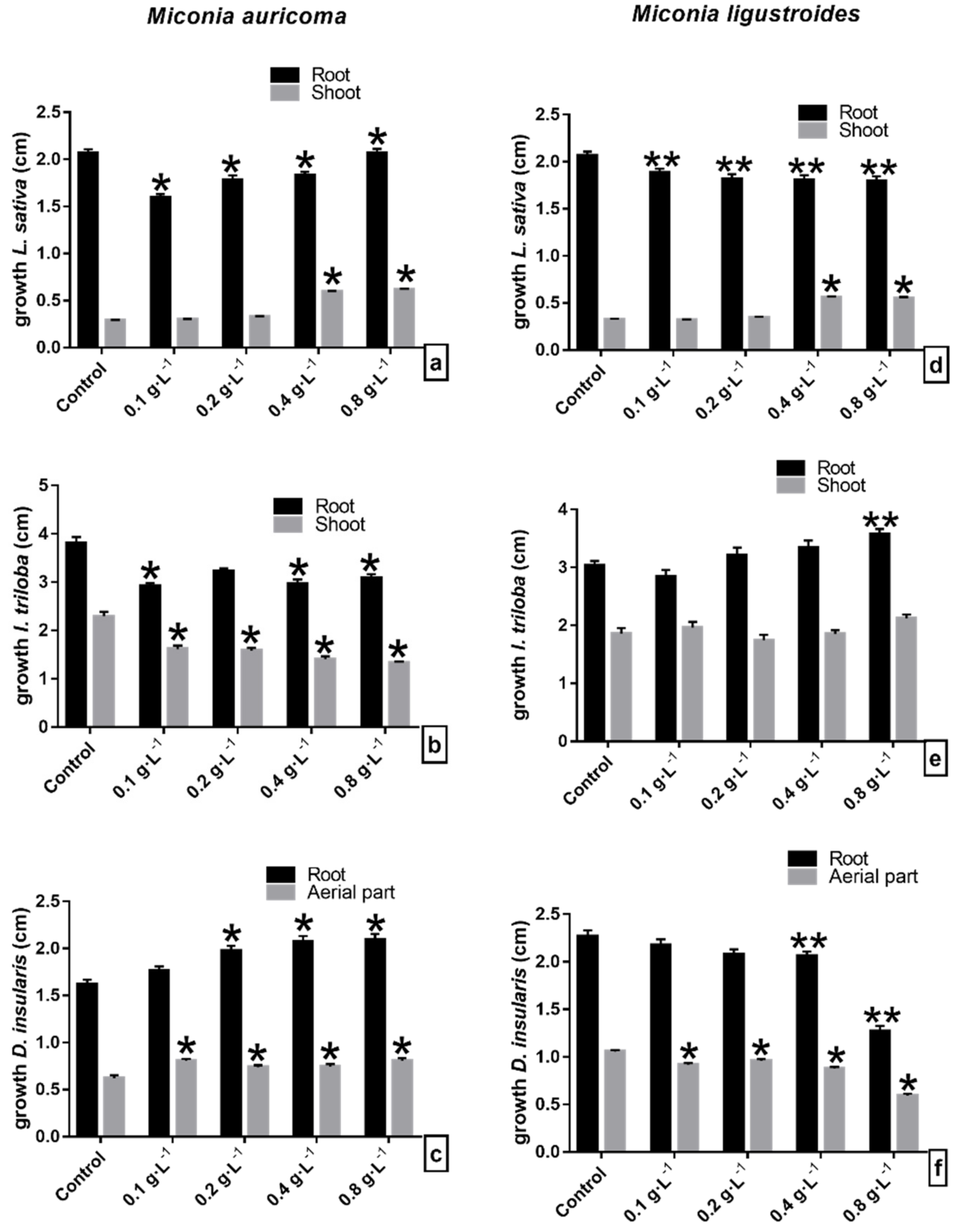
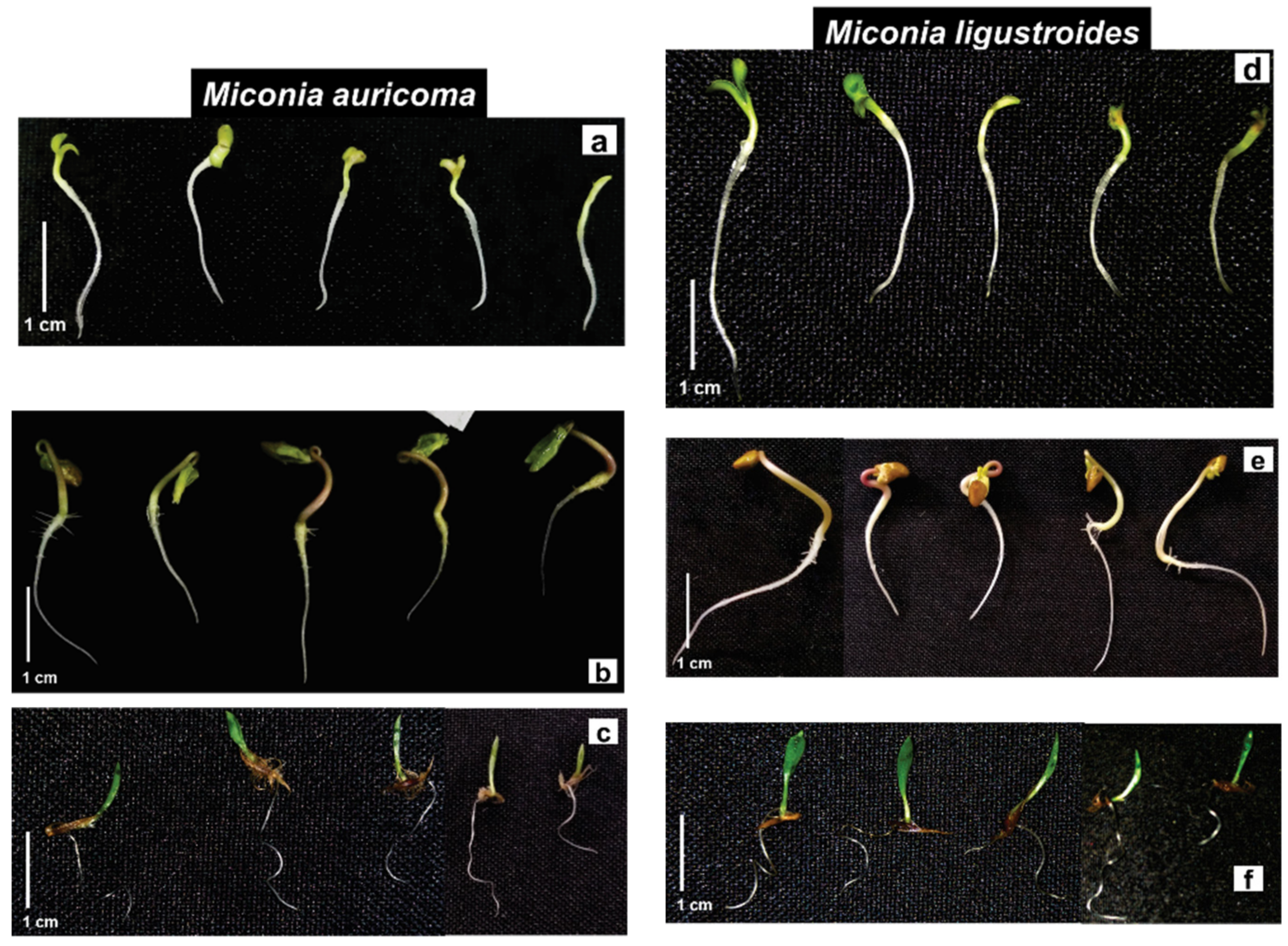
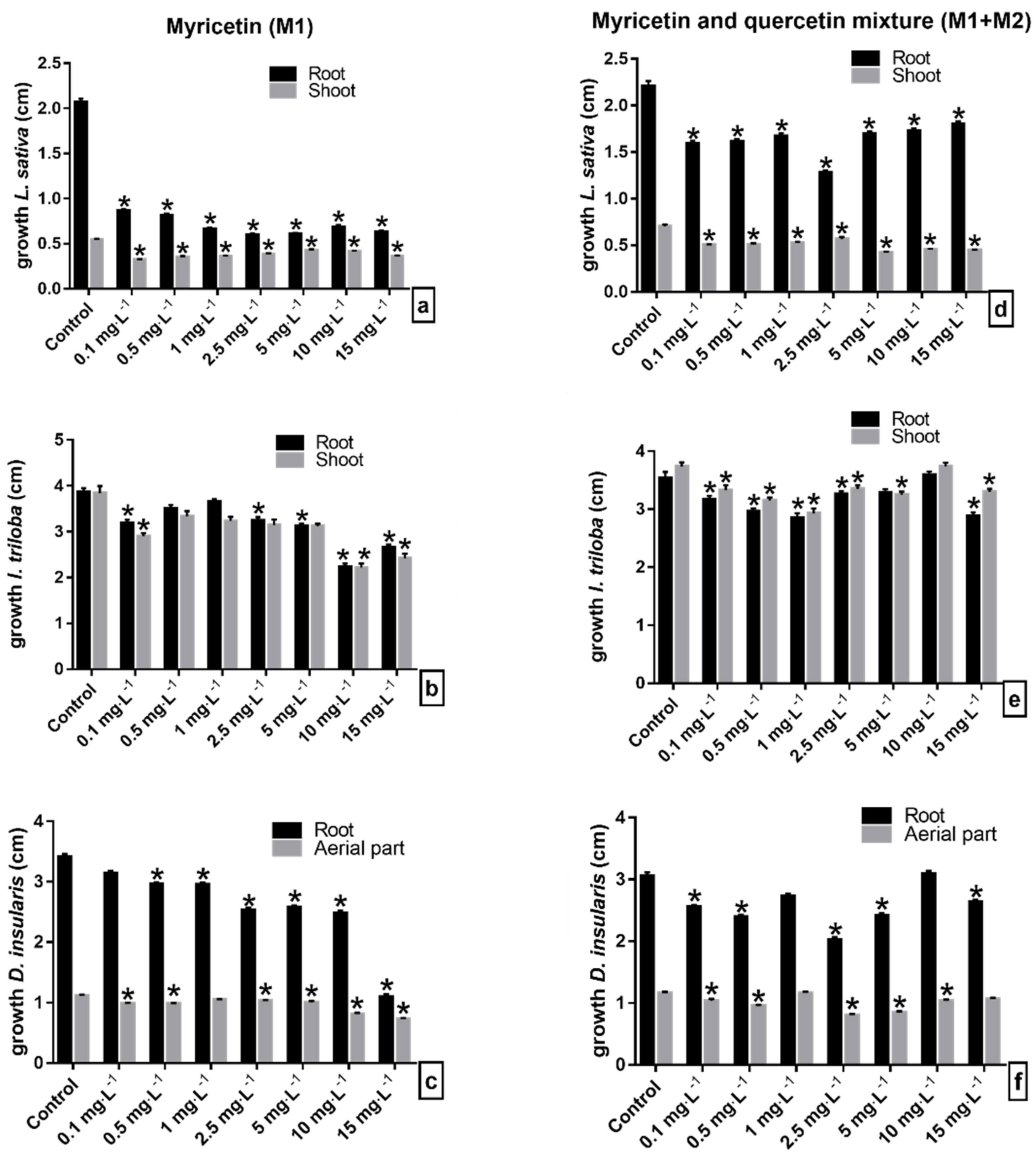


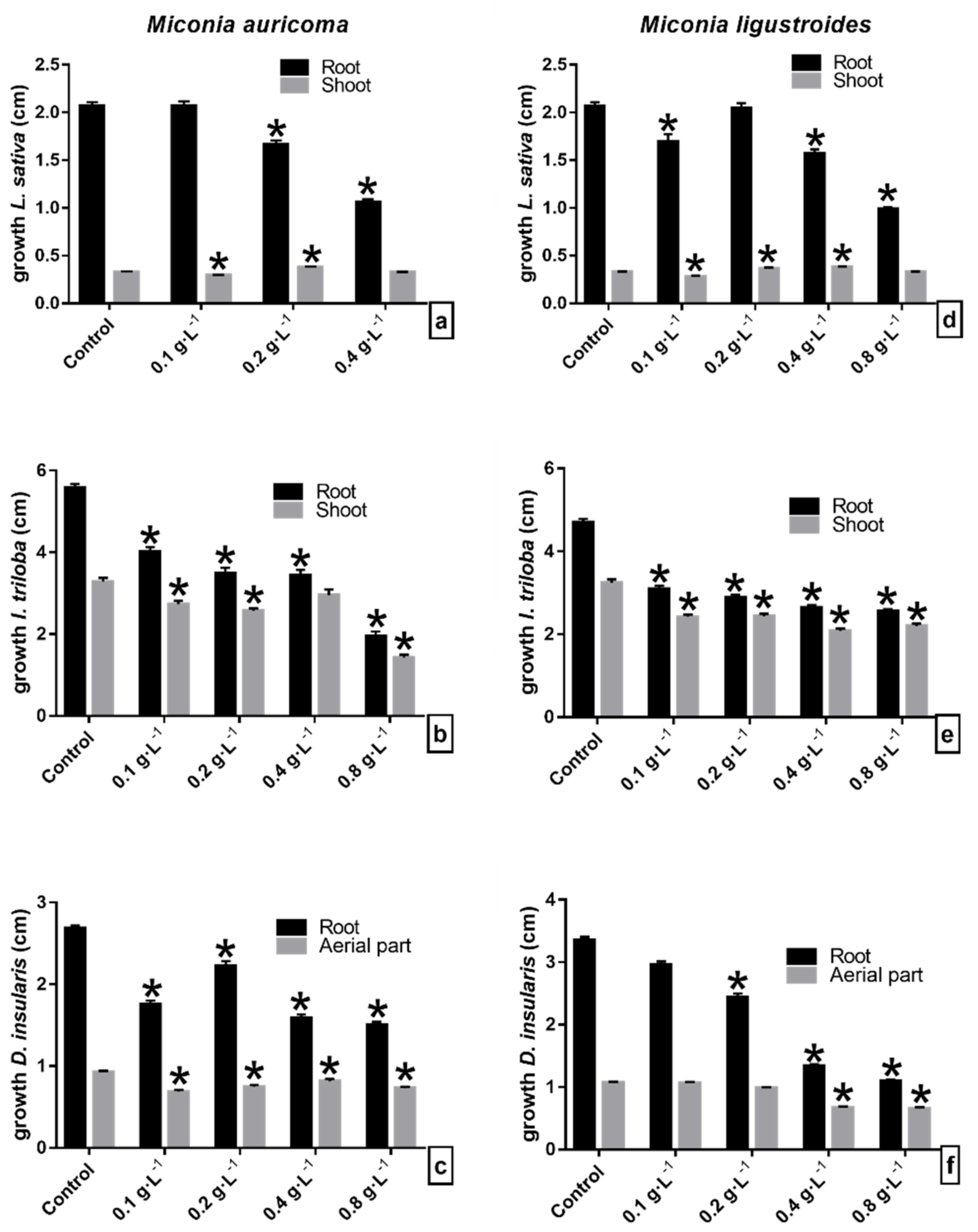

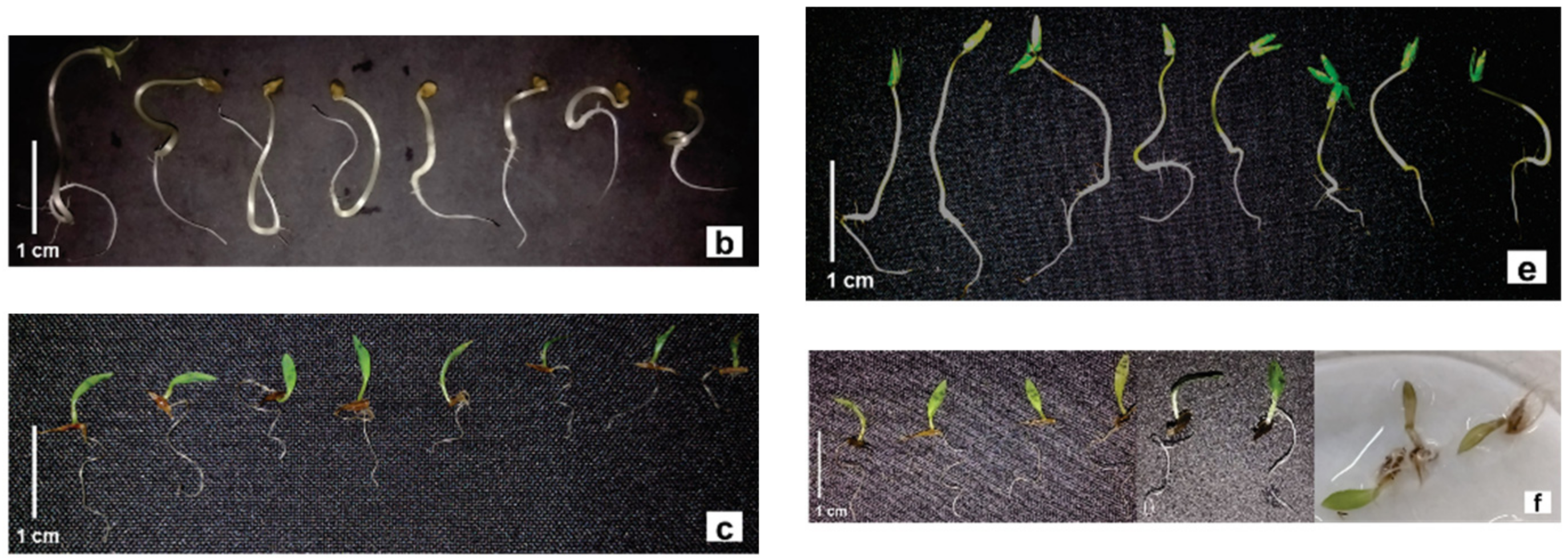
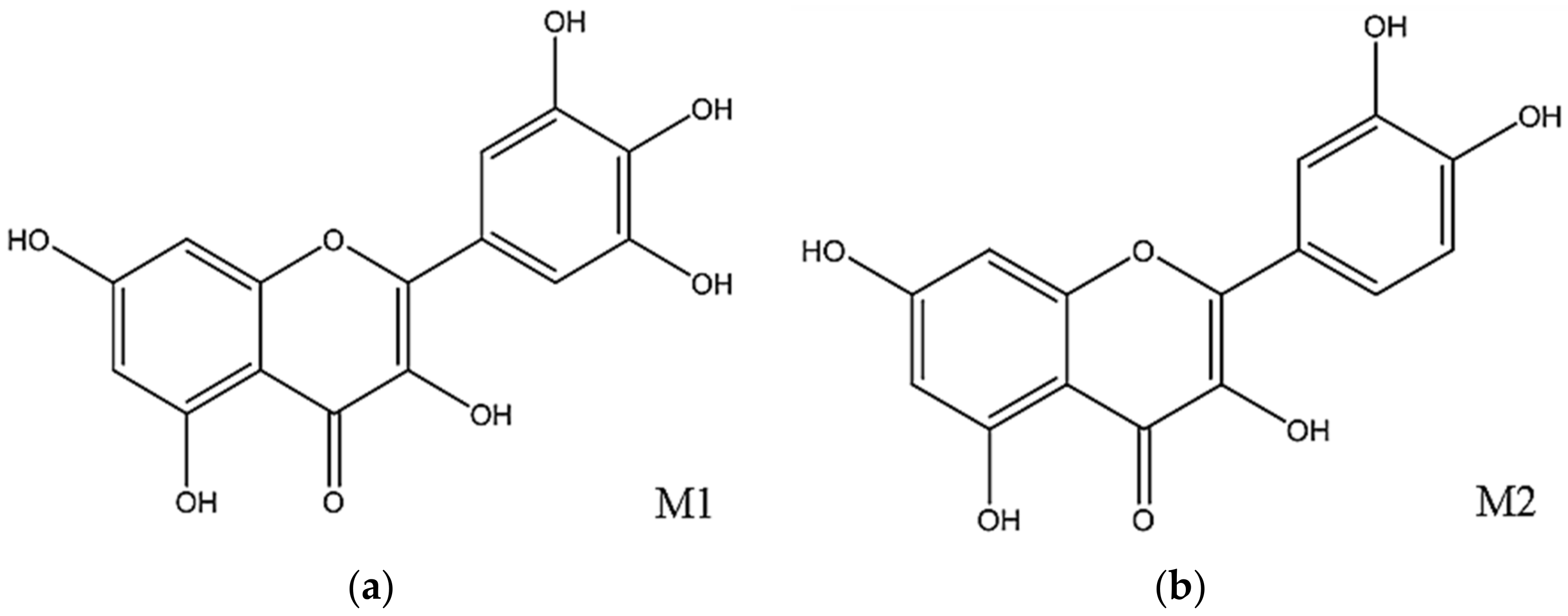
| Extract | Solvent | Solvent Volume | Fraction Code | Mass (g) |
|---|---|---|---|---|
| MLEB (32.27 g) | Hexane | 6 × 200 mL | MLEx | 2.52 |
| Chloroform | 8 × 200 mL | MLCHl3 | 5.13 | |
| Ethyl acetate | 6 × 200 mL | MLAcOEt | 6.60 | |
| H2O:MeOH | - | MLHM | 17.10 | |
| LAEB (37.30 g) | Hexane | 5 × 200 mL | LAHex | 2.08 |
| Chloroform | 7 × 200 mL | LACHl3 | 2.44 | |
| Ethyl acetate | 7 × 200 mL | LAAcOEt | 7.05 | |
| H2O:MeOH | - | LAHM | 25.53 |
Publisher’s Note: MDPI stays neutral with regard to jurisdictional claims in published maps and institutional affiliations. |
© 2022 by the authors. Licensee MDPI, Basel, Switzerland. This article is an open access article distributed under the terms and conditions of the Creative Commons Attribution (CC BY) license (https://creativecommons.org/licenses/by/4.0/).
Share and Cite
Ximenez, G.R.; Bianchin, M.; Carmona, J.M.P.; de Oliveira, S.M.; Ferrarese-Filho, O.; Pastorini, L.H. Reduction of Weed Growth under the Influence of Extracts and Metabolites Isolated from Miconia spp. Molecules 2022, 27, 5356. https://doi.org/10.3390/molecules27175356
Ximenez GR, Bianchin M, Carmona JMP, de Oliveira SM, Ferrarese-Filho O, Pastorini LH. Reduction of Weed Growth under the Influence of Extracts and Metabolites Isolated from Miconia spp. Molecules. 2022; 27(17):5356. https://doi.org/10.3390/molecules27175356
Chicago/Turabian StyleXimenez, Gabriel Rezende, Mirelli Bianchin, João Marcos Parolo Carmona, Silvana Maria de Oliveira, Osvaldo Ferrarese-Filho, and Lindamir Hernandez Pastorini. 2022. "Reduction of Weed Growth under the Influence of Extracts and Metabolites Isolated from Miconia spp." Molecules 27, no. 17: 5356. https://doi.org/10.3390/molecules27175356
APA StyleXimenez, G. R., Bianchin, M., Carmona, J. M. P., de Oliveira, S. M., Ferrarese-Filho, O., & Pastorini, L. H. (2022). Reduction of Weed Growth under the Influence of Extracts and Metabolites Isolated from Miconia spp. Molecules, 27(17), 5356. https://doi.org/10.3390/molecules27175356






